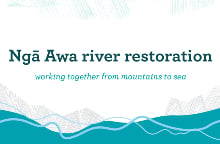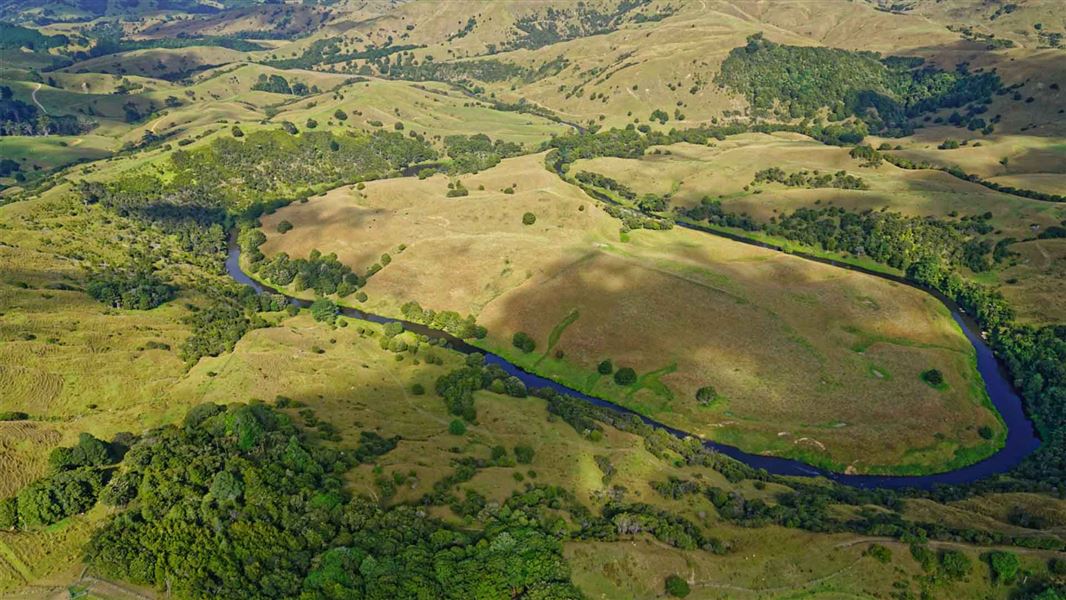Image gallery
About the river
The Hōteo River begins close to Te Arai Point on the east coast and travels southwest for 28 km to enter Kaipara Harbour. It is the biggest river in the Auckland region.
The river meanders through farmed hill country with areas of exotic forest. Only small areas of native forest and wetland remain in protected areas and reserves. These areas represent threatened environments that have been lost from most of the catchment. Near the coast, the river becomes salty and its last 3 km are lined with mangroves.
High terraces beside the river are formed from unstable silt and sand, which are prone to erosion during floods. Sand, silt and clay on the riverbed and floodplain also contribute to sediment that is washed downstream. The Hōteo River is a large contributor to the problematic sediment entering Kaipara Harbour.
Kaipara Harbour is New Zealand’s largest estuary, with a shoreline of 3,500 km and an area of nearly 950 square kilometres. It is the country’s largest snapper nursery area, contains areas of seagrass and is important bird habitat.
Current Ngā Awa restoration work
River restoration through Ngā Awa involves joining with agencies and groups already working in the catchment including mana whenua, local government, private landowners and community groups.
Our focus is to contribute to efforts to identify and protect the remnants of native ecosystems in the catchment. In the long term, these remnants could help to restore the biodiversity in larger areas.
Elevated water temperatures, phosphorus, sediment and turbidity are long-term issues that degrade water quality. Finding and planning ways to address these issues is part of the restoration work.
Hōteo gorge planting
The Hōteo gorge is a 5–6 km corridor beside the river. It includes a large remnant of mature native forest and wetlands on the river’s terraces and flood plain. This area is recognised as an Outstanding Natural Feature in the Auckland Unitary Plan.
In 2021 Ngā Awa commissioned a wetland restoration plan for the area. An archaeological assessment was also carried out to ensure no tapu (sacred) sites were present in the gorge.
4,500 native grasses (Carex lessoniana and Cyperus ustalatus) were planted in September 2023. These species were chosen as they are fast-growing and occur naturally on the stream banks. They also have large root mats, which will stabilise the banks and reduce erosion. In the next phase, larger trees will be planted on the upper banks.
Hōteo fish passage assessment
We are planning work with The Whitebait Connection to assess barriers to fish passage in the upper Hōteo River and its tributaries. This information will inform future work to restore populations of native fish, many of which are taonga species.
Hōteo catchment restoration work
Ngā Awa river restoration work is contributing to the restoration of the Hōteo catchment as well as the Kaipara Harbour. The catchment is a priority rural catchment in Auckland Council’s Sustainable Catchment Programme and a Ministry for the Environment at-risk catchment.
Kaipara Moana
The Kaipara Moana Remediation Programme is a decade-long project that aims to remediate the degradation of the Kaipara Moana. The programme is an equal partnership between the government, councils and Kaipara Uri. Its beginnings were the Integrated Kaipara Harbour Management Group, which was formed in 2005.
Forest Bridge Trust
The goal of the Forest Bridge Trust is to create a forest bridge from Kaipara Harbour to the east coast where native wildlife can flourish. This requires fencing of existing bush and wetland remnants, weed and pest management, and replanting. The trust works to create areas of protected biodiversity with the support of landowners and communities as well as offering help for fencing to individual landowners.
Hōteo Sediment Reduction Project
This work is led by Auckland Council. The project steering group includes representatives from the community as well as Ngāti Mahuhiri, the Integrated Kaipara Harbour Management Group, Ngā Maunga Whakahii o Kaipara, Te Uri O Hau (Kaipara Uri), Manaaki Whenua, Beef + Lamb and the Sustainable Business Network.
The project focuses on reducing sediment runoff in the Kourawhero Stream, a tributary of the Hōteo River. Nearly 12 km of waterways have been fenced and more than 60,000 plants have been planted beside the stream, some during community planting days.
Whitebait Connection
The Whitebait Connection has been working with Auckland Council since 2015 to find and improve habitat beside the lower reaches of Hōteo River where inanga spawn. They are working with local landowners and the Forest Bridge Trust to fence these sites.
Other projects
Landowners and many other organisations are involved in restoration projects in the catchment. These include Beef and Lamb NZ, Fonterra, Wai Care, Dairy NZ, forestry groups, lifestyle block owners, Auckland Council, Million Metres and Millbrook Quarry.
Native fish
Many species of native fish have been recorded in the Hōteo catchment. These include giant bully, torrent fish, īnanga, black mudfish and longfin eel, which all have a conservation status of At Risk- Declining.
Shortfin eel, common bully, Crans bully, banded kōkopu, redfin bully, smelt and yelloweye mullet are also present in the catchment.
Freshwater mussels and crustaceans
Kōura (freshwater crayfish) and freshwater crabs (Amarinus lacustris) are present in the Hōteo catchment.
Two species of freshwater mussel (kākahi/kāeo) are also found here:
- Echyridella aucklandica – conservation status of Threatened-Nationally Vulnerable
- Echyridella menziesii – conservation status of At Risk-Declining.
Contact
If you have any questions or want to get involved, email us.
Email: info@doc.govt.nz

About Ngā Awa river restoration
Ngā Awa is a programme working collaboratively in priority catchments to restore freshwater biodiversity.
